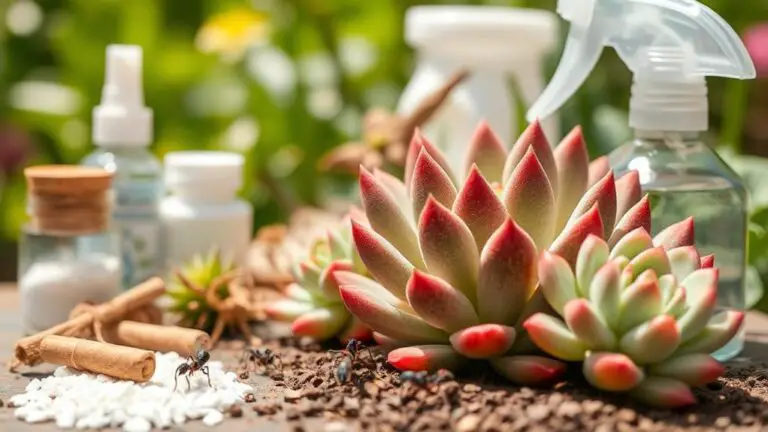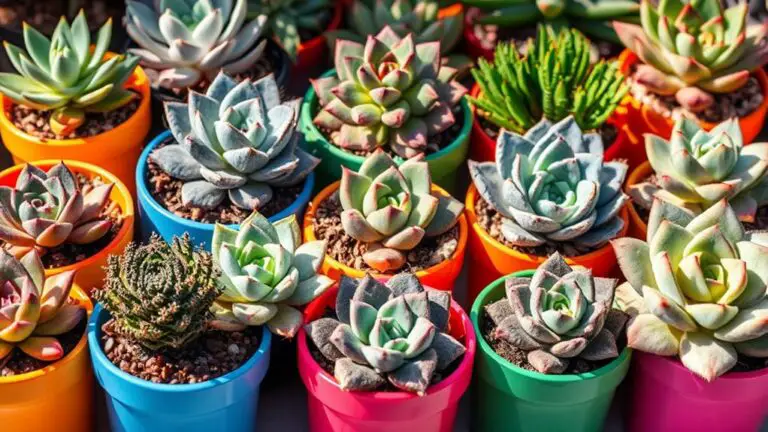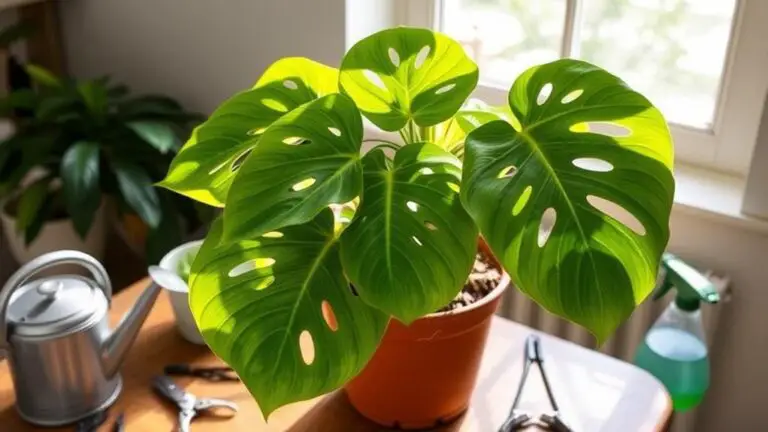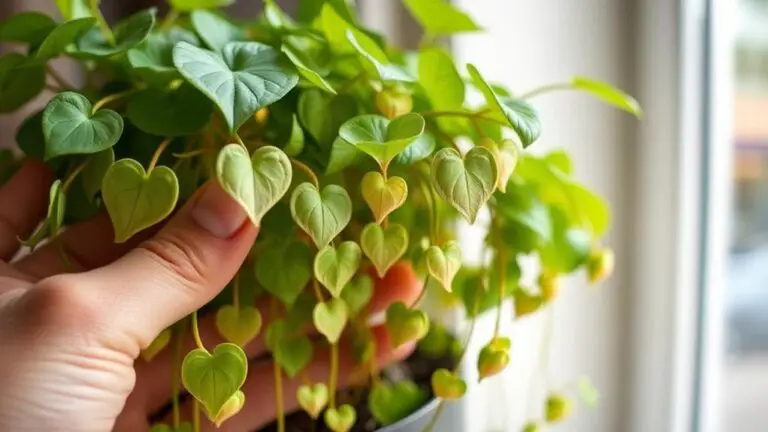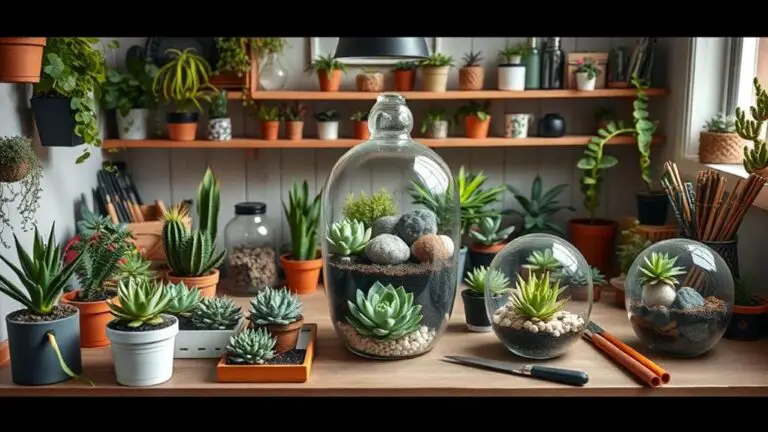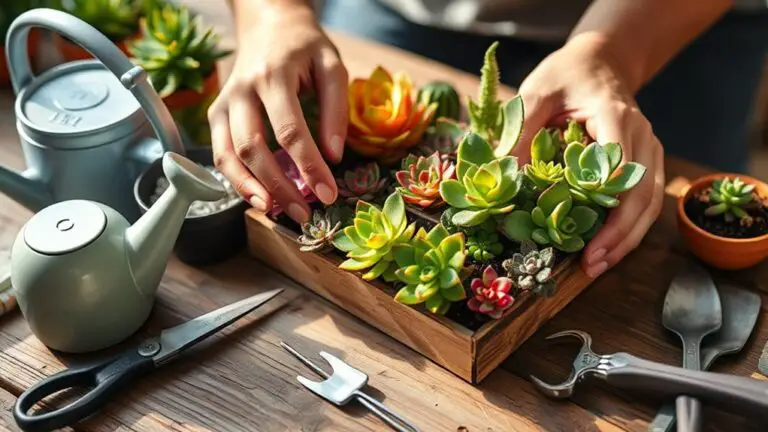Propagating Succulents From Leaves and Cuttings in 7 Easy Steps
If you're looking to expand your succulent collection without breaking the bank, propagating from leaves and cuttings is a practical approach. You'll start by gathering a few essential supplies and selecting healthy, mature succulents. The process involves a bit of patience and attention, especially when it comes to allowing the cut ends to callous and providing the right care. By following some straightforward steps, you can successfully grow new plants from your existing ones. Curious about the detailed steps and tips to guarantee successful propagation? Let's walk through the process together.
Gather Your Supplies

To begin propagating succulents, you'll need to gather a few vital supplies. First, find healthy adult succulents as they provide the best succulent leaves or leaf cuttings for propagation. When choosing your succulents, make certain they look vibrant and free from any signs of disease.
Next, you'll need succulent soil. This soil is lightweight and well-draining, which helps your new plants develop strong roots. Regular potting soil won't work as well because it retains too much moisture, which can cause rot.
Prepare a clean tray or pot with drainage holes. This guarantees that excess water can escape, preventing the roots from sitting in water. It's important to have a suitable container so you can easily observe the growth of your cuttings.
A fine spray bottle is another vital tool. You'll use it to lightly moisten the soil, keeping it at the right moisture level without overwatering. Proper moisture is essential for the early stages of propagation.
Lastly, sterilize all tools, like scissors or knives, with isopropyl alcohol. This step prevents the transfer of diseases to your plants.
With these supplies ready, you're set to start propagating your succulents successfully!
Remove Leaves and Cuttings

With your supplies gathered, it's time to remove leaves and cuttings from your succulents. First, select mature, bulbous leaves that are healthy and free of damage. These will have the best chance to grow roots and become new plants. To remove the leaf, gently pinch and rotate it at the stem. This helps detach it completely without breaking or damaging it.
If you're using cuttings, grab clean, sharp scissors or a knife. Cut the stem just below a growth node, making sure to leave 2-3 leaves at the top. These leaves will provide energy for the cutting as it starts to grow roots. Carefully remove lower leaves to avoid breaking them, as only intact leaves will successfully propagate.
Collect multiple leaves and cuttings to increase your chances of success. Here's a quick guide to keep in mind:
| Task | Details |
|---|---|
| Select Leaves | Choose mature, healthy, bulbous leaves |
| Remove Leaf | Gently pinch and rotate at the stem |
| Use Cuttings | Cut just below a growth node with clean, sharp tools |
| Keep Leaves Intact | Carefully remove lower leaves without breaking |
| Collect Multiple Samples | Increase success by gathering several leaves and cuttings |
Allow to Callous
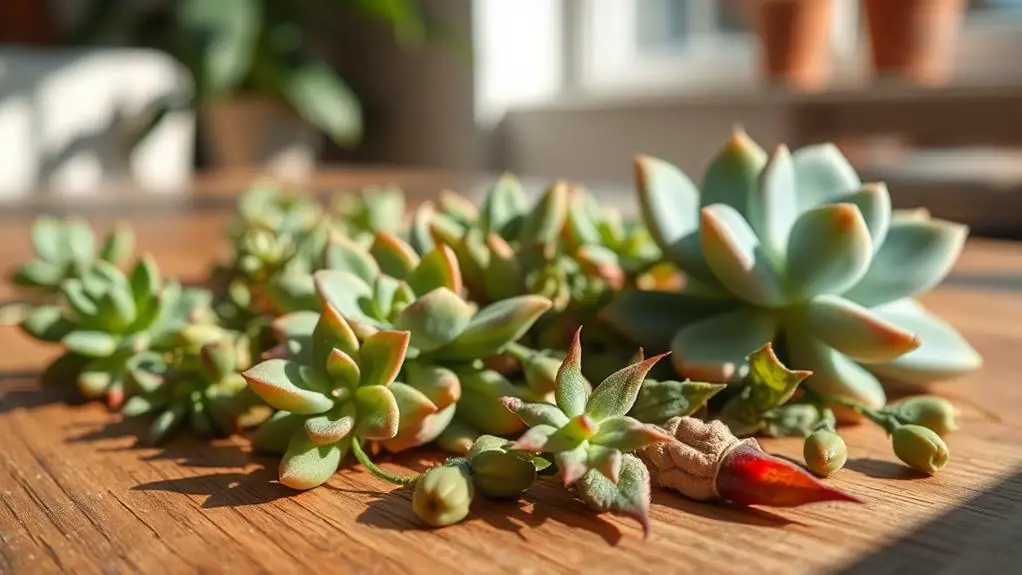
Allowing your succulent leaf cuttings to callous is an important step in ensuring successful propagation. This process helps prevent water from entering the cut end, which can cause the leaf to rot away.
To start, place your cuttings on a paper towel or any dry surface. This setup will absorb moisture and aid in drying out the cut end.
It's important to be patient during this stage. The callousing period usually takes about 3-4 days. However, if you live in a humid area, it may take up to a week for the cut end to fully heal.
While waiting, make sure the cut end is exposed to both air and light. This exposure is vital for forming a healthy base where new roots can develop—a good sign that your propagation is on the right track.
Plant in Soil

After your leaf cuttings have calloused for a few days, place them on top of well-draining succulent soil, making sure the cut end isn't buried.
Lightly mist the soil to keep it slightly damp but not soggy.
Position the cuttings in a warm spot with bright, indirect sunlight to help them root and grow.
Soil Preparation Techniques
Preparing the soil correctly is vital for successfully propagating succulents. Start by choosing a lightweight potting soil specifically designed for succulents or cacti. This type of soil guarantees proper drainage and aeration, which is essential for the leaves to root effectively.
Fill a tray or pot with a 2-inch layer of moist soil, making sure it's evenly distributed and lightly compressed for stability.
Once your succulent leaves have calloused for a few days, place the healed end of each leaf on top of the soil. Don't bury them; just lay them on the surface. This makes it easier for roots to develop.
Keep the soil consistently damp but not soggy. Overwatering can lead to rot, which will hinder your efforts to propagate succulents.
Choose a warm location with bright, indirect sunlight for your tray or pot. This environment encourages successful rooting.
Monitor the soil moisture closely, watering sparingly until roots appear. Remember, too much water can be detrimental, so aim for a balance.
Positioning Leaf Cuttings
Once you've prepared your soil, it's time to position your leaf cuttings for ideal growth.
Start by laying your healed leaf cuttings on top of the soil with the cut end facing down. Make sure not to bury the cut end; it needs light and air to develop roots properly.
Use a tray or pot filled with lightweight, well-draining succulent potting soil. This type of soil helps monitor the cuttings and prevents excess moisture, which can cause rot.
Positioning leaf cuttings correctly is essential for their growth. Remember, the leaves should rest on the soil surface without being submerged.
Water your leaf cuttings sparingly. About 2-4 times a week should suffice, but adjust based on temperature and humidity. You want to keep the soil slightly moist without overwatering. This balance is key to preventing rot and encouraging new root growth.
Place the tray or pot in a location where it will receive bright, indirect sunlight. Too much direct light can scorch the leaves before they establish roots.
Keep an eye on your cuttings for signs of growth, like new roots or baby succulents. Once the pups are well established, remove the shriveled mother leaves.
Happy propagating!
Optimal Light Conditions
Proper light conditions are essential for the successful propagation of succulent leaf cuttings. To start, you'll want to place your cuttings in bright, indirect light. This helps prevent scorching while promoting healthy growth. Direct sunlight for prolonged periods can burn the leaves and hinder your propagation efforts.
To achieve ideal light conditions, follow these tips:
- Filtered Light: Position your cuttings near a south or east-facing window where they receive filtered light. This gives them the brightness they need without the risk of direct sunburn.
- Avoid Direct Sunlight: Make sure your cuttings aren't exposed to direct sunlight for long periods. Just a little direct sun can be harmful, so keep an eye on them.
- Use LED Grow Lights: If natural light is limited, consider using LED grow lights. They can provide the necessary brightness for successful rooting and growth.
Regularly monitor the light exposure of your cuttings. If you notice they're getting leggy, they might need more light.
Adjust their placement as needed, ensuring they get enough light but not too much. By following these steps, you'll set up your succulent cuttings for success!
Water and Light Care
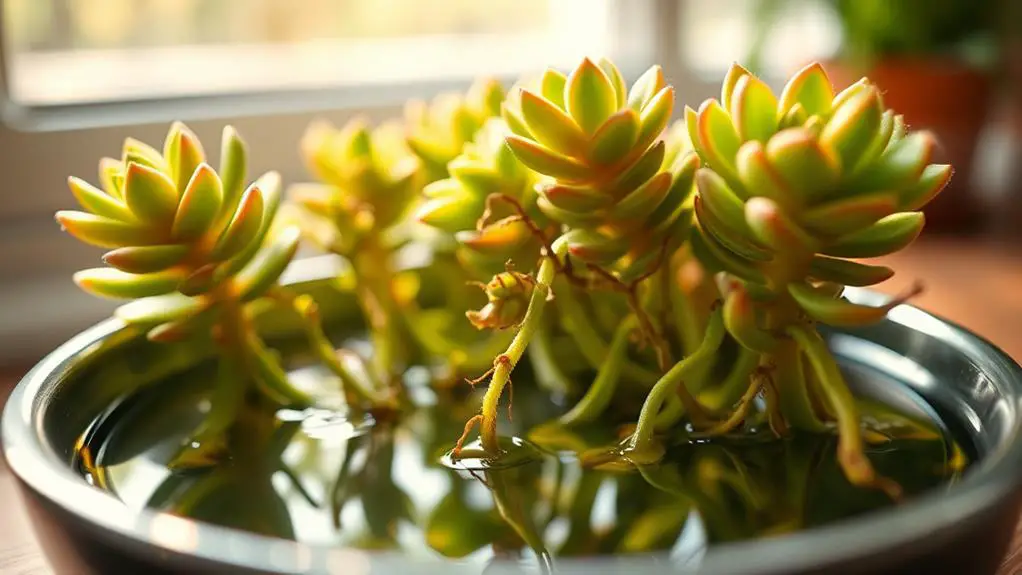
When taking care of your succulent cuttings, you'll need to water them 2-4 times a week, adjusting based on temperature and humidity to keep the soil moist but not soggy.
Make sure they get bright, indirect light, as too much direct sunlight can scorch their leaves.
Keep an eye on your cuttings for signs of overwatering, like blackened or shriveled leaves, and tweak your care routine as needed.
Optimal Watering Frequency
Watering your succulent leaf cuttings is a delicate balance that requires attention to temperature and humidity. You'll need to water your leaf cuttings about 2-4 times a week, but adjust this frequency based on the conditions in your home. The goal is to keep the soil moist, not drenched, so avoid any standing water which can cause root rot.
To help you with watering:
- Check Soil Moisture: Before watering, feel the soil. If it's dry to the touch, it's time to water.
- Adjust for Environment: Higher temperatures and lower humidity mean you'll need to water more often.
- Watch for Signs: Yellowing or blackening leaves can indicate overwatering, so cut back if you see these symptoms.
As your cuttings start to develop roots, you can gradually reduce watering to about once a week. This helps the new succulents get used to their growing conditions.
Remember, the key is maintaining just the right amount of moisture without letting the soil stay soggy. This careful balance will encourage healthy root growth and prevent damage.
Light Exposure Guidelines**
Guaranteeing your succulent leaf cuttings receive the right amount of light is crucial for their growth.
You'll want to provide bright indirect light to your cuttings. This type of light is perfect because it promotes healthy growth without causing any scorching. Direct sunlight, especially prolonged direct sunlight, can lead to leaf damage and dehydration.
To create ideal growth conditions, avoid placing your cuttings in spots where they'll get too much direct sunlight. Instead, find a bright spot that doesn't have the sun shining directly on the leaves.
If natural sunlight isn't enough, you might consider using LED grow lights. These can help guarantee your succulents get the light exposure they need.
Monitor Growth

Keeping a close eye on your succulent cuttings is essential to confirm they grow healthily. Regularly monitoring growth will help you spot any issues early and confirm your plants are getting enough care. Here are a few key points to focus on:
- Root Development: Check your cuttings for root development, which usually starts within 2-6 weeks. Gently tug on the leaves to see if they resist, indicating roots are forming.
- Leaf Condition: Observe the condition of the leaves. Healthy leaves should maintain their color and texture. If you notice shriveling or blackening, it could mean there's a problem, such as too much or too little water.
- Soil Moisture: Monitor soil moisture levels closely. Overwatering can be harmful, so allow the soil to dry out a bit between watering sessions. This helps prevent root rot.
As your cuttings begin to grow, keep an eye out for baby succulents emerging from the cuttings. Sometimes these pups appear before roots are fully developed, which is a good sign.
Adjust the light exposure if you notice the leaves starting to sunburn; move them to a spot with bright, indirect light. With careful monitoring, your succulents will thrive!
Transplant New Succulents
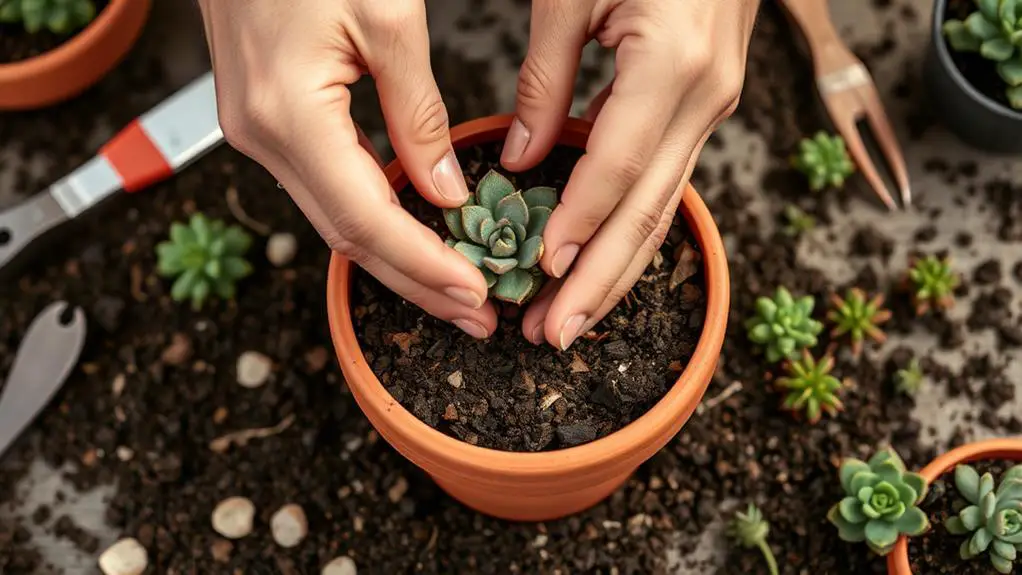
Once you've confirmed your succulent cuttings have developed a healthy root system, it's time to transplant them into their new homes. This usually takes about 4-6 weeks.
Start by choosing a pot with drainage holes to prevent water from accumulating and causing root rot.
Next, fill the pot with a succulent potting mix. This special soil provides the right amount of drainage and aeration that your new succulents need.
Carefully remove your succulent cuttings from their original container. Gently shake off any excess soil, being careful not to damage the delicate roots.
Place each cutting into the new pot, making sure the roots are well-covered with the potting mix.
Once planted, water them thoroughly. This helps the soil settle around the roots. After the initial watering, let the soil dry out completely before watering again.
As your succulents adjust to their new environment, gradually introduce them to brighter light. This prevents sunburn on their leaves.
Start with indirect sunlight and slowly move them to a sunnier spot over a few weeks.
With these steps, your new succulents should thrive in their new homes, showcasing their beauty and resilience.
Frequently Asked Questions
What Is the Fastest Way to Propagate Succulents From Leaves?
The fastest way to propagate succulents from leaves is to gently remove mature, healthy leaves, let them callous for 2-5 days, then place them on well-draining soil. Water sparingly, and watch for roots and pups in 4-6 weeks.
Can You Put Succulent Cuttings Straight Into Soil?
You shouldn't put succulent cuttings straight into soil. Let them callous for a few days to prevent rot. This helps the cuttings resist moisture and promotes root growth. Once calloused, place them on well-draining soil without burying the cut end.
Should I Spray Water on My Succulent Leaves Every Day When Propagating?
You shouldn't spray water on your succulent leaves every day when propagating. Lightly mist them every few days, letting the soil dry out in between. Over-watering can cause rot, so monitor for signs of dehydration instead.
How to Propagate Succulents Indoors?
You can propagate succulents indoors by placing cuttings in well-lit, indirect light. Use a succulent mix, let cuttings callous for a few days, and water sparingly. Monitor for root growth and be patient—it takes 4-6 weeks.
Conclusion
You've got the steps down, so now it's time to get your hands dirty and start propagating succulents. Remember, patience is key. Keep an eye on moisture levels, give them plenty of indirect sunlight, and watch those roots grow. It's okay if it takes a few tries to get it just right. With practice, you'll soon have a thriving collection of new succulents. You've got this! Happy gardening!


